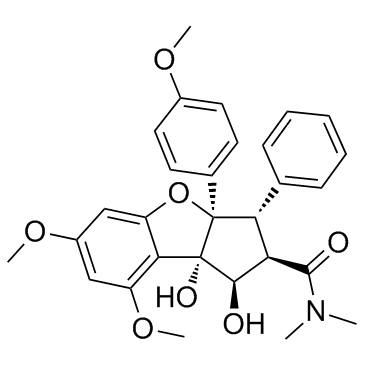Rocaglamide (Rocaglamide A) (Synonyms: Rocaglamide A; Roc-A) |
| Catalog No.GC33426 |
Rocaglamide (Rocaglamide A) (Roc-A) est isolé du genre Aglaia et peut être utilisé pour la toux, les blessures, l'asthme et les maladies inflammatoires de la peau. Le Rocaglamide (Rocaglamide A) est un puissant inhibiteur de l'activation de NF-κB dans les lymphocytes T. Le rocaglamide (Rocaglamide A) est un inhibiteur puissant et sélectif de l'activation du facteur de choc thermique 1 (HSF1) avec une IC50 d'environ 50 nM. Rocaglamide (Rocaglamide A) inhibe la fonction du facteur d'initiation de la traduction eIF4A. Rocaglamide (Rocaglamide A) a également des propriétés anticancéreuses dans la leucémie.
Products are for research use only. Not for human use. We do not sell to patients.

Cas No.: 84573-16-0
Sample solution is provided at 25 µL, 10mM.
Rocaglamide (Rocaglamide A) is isolated from the genus Aglaia (family Meliaceae). Rocaglamide (Rocaglamide A)(IC50 of 50 nM) inhibits the function of the translation initiation factor eIF4A, a DEAD box RNA helicase [1,2].
Rocaglamide (Rocaglamide A) (100 nM;24h) significantly enhanced TRAIL induced apoptosis[4]. Rocaglamide (Rocaglamide A) (20- 100 nM;48h)can induce 10-30% apoptosis of L1236 and KM-H2 cells [3]. Rocaglamide (Rocaglamide A) are able to suppress the PMA-induced expression of NF-kappaB target genes and sensitize leukemic T cells to apoptosis induced by TNFalpha, cisplatin, and gamma-irradiation [5]. Rocaglamide (Rocaglamide A)( 30/50 nM;21d) prevented TNF-α mediated inhibition of osteoblast differentiation, and promoted osteoblast differentiation directly, in both C2C12 and primary mesenchymal stromal cells [6].
Rocaglamide (Rocaglamide A)( 2.5 mg/kg; i.p.; 32 days) induced tumor cell apoptosis in a SCID mouse model (Huah-7 cells) without causing weight loss in mice, and no significant signs of toxicity were observed during treatment, suggesting that Rocaglamide is generally well tolerated in vivo[4]. Rocaglamide (Rocaglamide A)( 0.5 mg/kg; i.p.; five times per week for two weeks) overcomes CPT resistance in U266 in vitro and significant increases in anti-tumor efficacies of CPT in mice xenografted with U266[7].
References:
[1]. Santagata S, Mendillo ML, et,al. Tight coordination of protein translation and HSF1 activation supports the anabolic malignant state. Science. 2013 Jul 19;341(6143):1238303. doi: 10.1126/science.1238303. PMID: 23869022; PMCID: PMC3959726.
[2]. Kim S, Salim AA, Swanson SM and Kinghorn AD: Potential of cyclopenta[b]benzofurans from Aglaia species in cancer chemotherapy. Anticancer Agents Med Chem. 6:319-345. 2006.
[3]. Giaisi M, KÖhler R, et,al. Rocaglamide and a XIAP inhibitor cooperatively sensitize TRAIL-mediated apoptosis in Hodgkin's lymphomas. Int J Cancer. 2012 Aug 15;131(4):1003-8. doi: 10.1002/ijc.26458. Epub 2011 Nov 8. PMID: 21952919.
[4]. Luan Z, He Y, et,al. Rocaglamide overcomes tumor necrosis factor-related apoptosis-inducing ligand resistance in hepatocellular carcinoma cells by attenuating the inhibition of caspase-8 through cellular FLICE-like-inhibitory protein downregulation. Mol Med Rep. 2015 Jan;11(1):203-11. doi: 10.3892/mmr.2014.2718. Epub 2014 Oct 21. PMID: 25333816; PMCID: PMC4237083.
[5]. Baumann B, Bohnenstengel F, et,al. Rocaglamide derivatives are potent inhibitors of NF-kappa B activation in T-cells. J Biol Chem. 2002 Nov 22;277(47):44791-800. doi: 10.1074/jbc.M208003200. Epub 2002 Sep 16. PMID: 12237314.
[6]. Li A, Yang L, et,al. Rocaglamide-A Potentiates Osteoblast Differentiation by Inhibiting NF-κB Signaling. Mol Cells. 2015 Nov;38(11):941-9. doi: 10.14348/molcells.2015.2353. Epub 2015 Nov 6. PMID: 26549505; PMCID: PMC4673408.
[7]. Wu Y, Giaisi M, et,al. Rocaglamide breaks TRAIL-resistance in human multiple myeloma and acute T-cell leukemia in vivo in a mouse xenogtraft model. Cancer Lett. 2017 Mar 28;389:70-77. doi: 10.1016/j.canlet.2016.12.010. Epub 2016 Dec 18. PMID: 27998762.
Average Rating: 5 (Based on Reviews and 39 reference(s) in Google Scholar.)
GLPBIO products are for RESEARCH USE ONLY. Please make sure your review or question is research based.
Required fields are marked with *




















